
 This typical
H. 'Fortunei' type hosta was
originated by
Cynthia Tompkins of Oregon and registered by
Peter Ruh of Ohio and
Paul Hofer
of Antioch Farms in Ohio in 1979. It has become one of the
classic marginal variegated hostas and it is a fast grower. The
plant forms a large size (24 inches high by 56 inches wide) mound with medium lavender
flowers in mid to late July. This typical
H. 'Fortunei' type hosta was
originated by
Cynthia Tompkins of Oregon and registered by
Peter Ruh of Ohio and
Paul Hofer
of Antioch Farms in Ohio in 1979. It has become one of the
classic marginal variegated hostas and it is a fast grower. The
plant forms a large size (24 inches high by 56 inches wide) mound with medium lavender
flowers in mid to late July.
 The Hosta Handbook
by Mark Zilis (2000) states that
"Originally developed by
Cynthia Tompkins in the 1920's, it has been sold under a variety of names
including Hosta fortunei aureo-marmorata, 'Moorheimii' and 'Spinners'.
Additionally 'Fortunei Albomarginata' ('Silver Crown') is often
confused with 'Antioch'." The Hosta Handbook
by Mark Zilis (2000) states that
"Originally developed by
Cynthia Tompkins in the 1920's, it has been sold under a variety of names
including Hosta fortunei aureo-marmorata, 'Moorheimii' and 'Spinners'.
Additionally 'Fortunei Albomarginata' ('Silver Crown') is often
confused with 'Antioch'."
According to
The Hostapedia by Mark Zilis (2009), "...continues to be sold by many sources as 'Moerheim',
'Hadspen Rainbow' and 'Spinners'.
From the
Field Guide to Hostas by Mark Zilis (2014), "...still rates highly among white-edged hostas for its
vigorous growth rate and distinct variegation."
The New Encyclopedia of Hostas by
Diana
Grenfell (2009) states: "Emerges late. Winner of the 1984 Alex J. Summers
Distinguished Merit Hosta Award."
 "AHS
multiple award winner: Eunice Fisher Award, 1986...Alex
J. Summers Distinguished Merit Award Hosta, 1984,
selected by Peter Ruh...Plants sold in the United
Kingdom under the names H. 'Goldbrook' and H.
'Spinners' are very similar but have narrower leaves
which may become wider and equal to H.
'Antioch'...According to Tompkins (1985), a similar
taxon was given the seedling number 1928-7 W E in the
1920s and has subsequently been identified as H.
'Antioch'. Side-by-side comparisons of H.
'Shogun' and H. 'Antioch' show both to be very
much alike. In all of these plants the margin color
starts out yellow and turns white. Hosta
'Antioch' is frequently and incorrectly sold as H.
'Fortunei Albomarginata' but the latter is a distinct
plant when mature...and has margins that start out
almost white and remain that color." "AHS
multiple award winner: Eunice Fisher Award, 1986...Alex
J. Summers Distinguished Merit Award Hosta, 1984,
selected by Peter Ruh...Plants sold in the United
Kingdom under the names H. 'Goldbrook' and H.
'Spinners' are very similar but have narrower leaves
which may become wider and equal to H.
'Antioch'...According to Tompkins (1985), a similar
taxon was given the seedling number 1928-7 W E in the
1920s and has subsequently been identified as H.
'Antioch'. Side-by-side comparisons of H.
'Shogun' and H. 'Antioch' show both to be very
much alike. In all of these plants the margin color
starts out yellow and turns white. Hosta
'Antioch' is frequently and incorrectly sold as H.
'Fortunei Albomarginata' but the latter is a distinct
plant when mature...and has margins that start out
almost white and remain that color."

Mark Zilis (2009)
says this about Chet Tompkins' mother, "Cynthia Tompkins was way ahead of
her time, considering that 'Snowbound' and many of her other cultivars predated the formation of
The
American Hosta Society by more than thirty years. In fact,
one could make a case for her being considered the first
American hosta hybridizer. The only difference between her and
people like
Frances
Williams, Elizabeth
Nesmith, and
Eunice
Fisher was the lack of publicity for her plants."
 Antioch is an ancient city in Turkey. Antioch is an ancient city in Turkey.

 Warren I. Pollock wrote about H. 'Antioch' by in
The
Hosta Journal (1985 Vol. 16), "Chet Tompkins
of Canby, Oregon believes he can trace this hosta to one of his mother's plants
dating back to 1928...Among the several hosta varieties that his mother
sold to the old Wayside Gardens of Mentor, Ohio, from 1936 to 1940, one had the
designation "1928 #7 W.E." (W.E. meant White Edged.) Most assuredly this hosta
is the one we now call H. 'Antioch'...I have a copy of the 1973 Wayside Gardens'
catalogue and it lists "H. fortunei aurea marmorta"...another example where
nursery people -- not botanists -- have given a Latin botanical name to a
hosta..."aurea marmorta" means "marbled with gold"...Chet Tompkins' mother's
"1928 #7 W.E." became "H. fortunei Aurea Marmorata" which gave way to H.
'Antioch'." Warren I. Pollock wrote about H. 'Antioch' by in
The
Hosta Journal (1985 Vol. 16), "Chet Tompkins
of Canby, Oregon believes he can trace this hosta to one of his mother's plants
dating back to 1928...Among the several hosta varieties that his mother
sold to the old Wayside Gardens of Mentor, Ohio, from 1936 to 1940, one had the
designation "1928 #7 W.E." (W.E. meant White Edged.) Most assuredly this hosta
is the one we now call H. 'Antioch'...I have a copy of the 1973 Wayside Gardens'
catalogue and it lists "H. fortunei aurea marmorta"...another example where
nursery people -- not botanists -- have given a Latin botanical name to a
hosta..."aurea marmorta" means "marbled with gold"...Chet Tompkins' mother's
"1928 #7 W.E." became "H. fortunei Aurea Marmorata" which gave way to H.
'Antioch'." In
an article about leaf color change in
The
Hosta Journal (1991 Vol. 22 No. 1), Warren I. Pollock cites an extract from
The Genus Hosta by W. George Schmid (1991) on seasonal changes in hosta leaf
colors with the following definitions:
| Viridescence |
Emerging with yellow or whitish
color that ultimately become increasingly green. An example is
H. 'Fortunei Albopicta' whose green-bordered leaves have a
beautiful, bright yellow-colored center in the spring that turns to
green by midseason. |
| Partial Viridescence |
Emerging with yellow or whitish
color that turns to chartreuse (yellowish green), sometimes a dark
chartreuse. One example is H. 'Kabitan'; two others are 'Golden
Scepter'...and the center leaf coloring of 'Golden
Tiara'. |
| Lutescence |
Emerging green or chartreuse and
turning yellow or whitish yellow. The coloring of leaf centers
of 'Gold Standard'. ..is an example. |
| Albescence |
Yellow, yellowish green or green
areas that turn to near white. Examples are the center leaf
coloring of 'Janet'...and the margins of 'Antioch'...and H. ventricosa 'Aureomarginata'. |
An article in
The Hosta Journal (1995 Vol. 26 No. 1) citing Vol. 1, #2, Fall 1993,
Great Lakes Region Newsletter included a list of 10 Classic Hostas from renowned
hostaphile,
Peter Ruh:
 Bob Keller
wrote a piece titled Too Many Lookalikes in
The
Hosta Journal (2010 Vol. 41 No. 2) where he stated that, "There
are other examples of lookalikes being registered. H. 'Ellerbroek' and 'Fortunei Aureomarginata' are nearly identical in my view, as are 'Antioch' and
'Spinners'. H. 'Patriot' and Minuteman'; 'Great Escape', 'Sleeping
Beauty',
'First Frost' and 'El Nino';
White Bikini' and 'Risky Business' - the list goes
on...H. 'Blue Flame' and 'Secret Love', are both sports of 'Fragrant Blue', are
very similar. There are a host of margined 'Sum and Substance' lookalikes." Bob Keller
wrote a piece titled Too Many Lookalikes in
The
Hosta Journal (2010 Vol. 41 No. 2) where he stated that, "There
are other examples of lookalikes being registered. H. 'Ellerbroek' and 'Fortunei Aureomarginata' are nearly identical in my view, as are 'Antioch' and
'Spinners'. H. 'Patriot' and Minuteman'; 'Great Escape', 'Sleeping
Beauty',
'First Frost' and 'El Nino';
White Bikini' and 'Risky Business' - the list goes
on...H. 'Blue Flame' and 'Secret Love', are both sports of 'Fragrant Blue', are
very similar. There are a host of margined 'Sum and Substance' lookalikes."
| |
| |
|
An article by
Warren I. Pollack in
The
Hosta Journal (2020 Vol. 51 No. 1) titled
Doppelgänger Hostas:
Fancy Name for Look-alike Hostas, included a long list of hostas which various
hostaphiles, published articles or other
sources have indicated "look" the same. Some
of these are, in fact, the same plant with
two or more different names. Others are
hostas that vary in some minor trait which
is not immediately discernable to the casual
observer such as seasonal color variations, bloom traits, ploidy, etc. So, as Warren
mentions, hostaphiles may differ as to the
plants listed but then, their opinions are based on visual observations and
interpretations. |
| |
 H.
'Antioch',
H. 'Moerheim',
H. 'Shogun' and
H. 'Spinners'. H.
'Antioch',
H. 'Moerheim',
H. 'Shogun' and
H. 'Spinners'. |


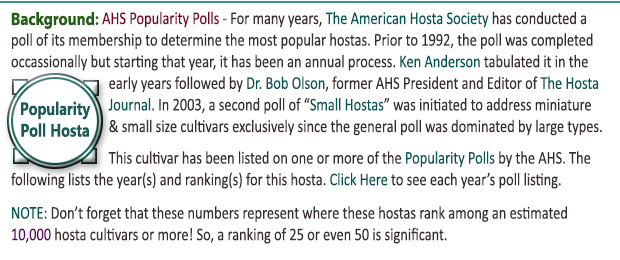 |
 |
 |
 |
| 5 |
18.2 |
1985 #15
1990 #16 |
1991 #19
1992 #19 |
1993 #22 |
|
|
|
|
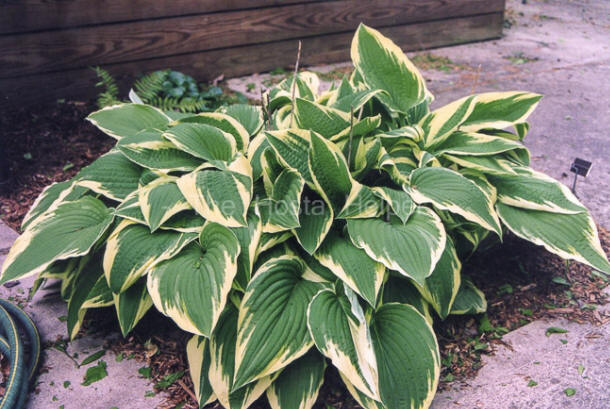


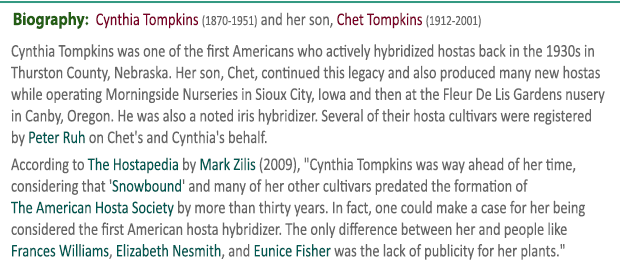



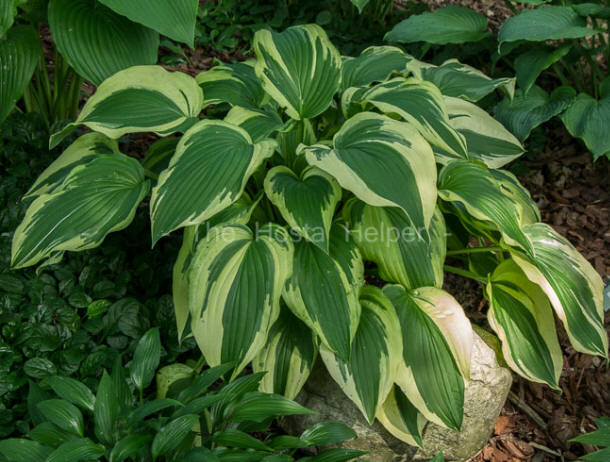

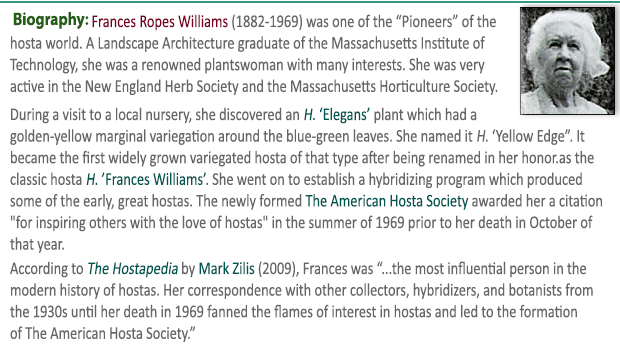



 |



